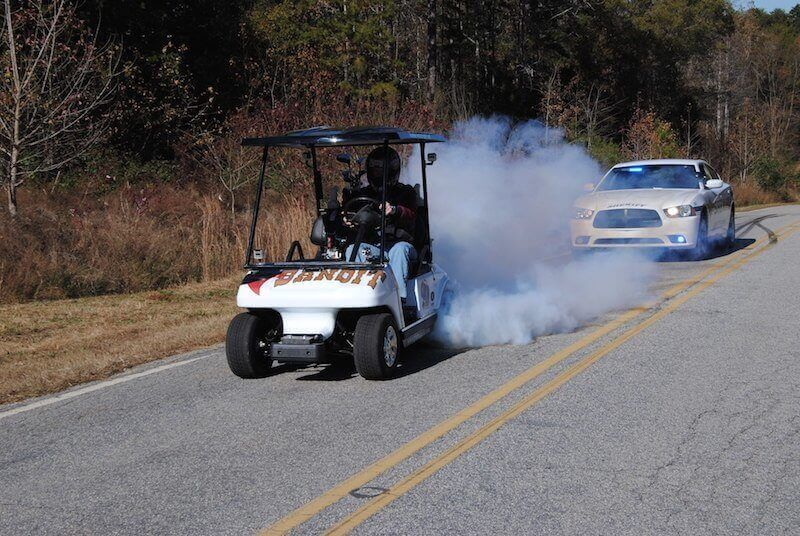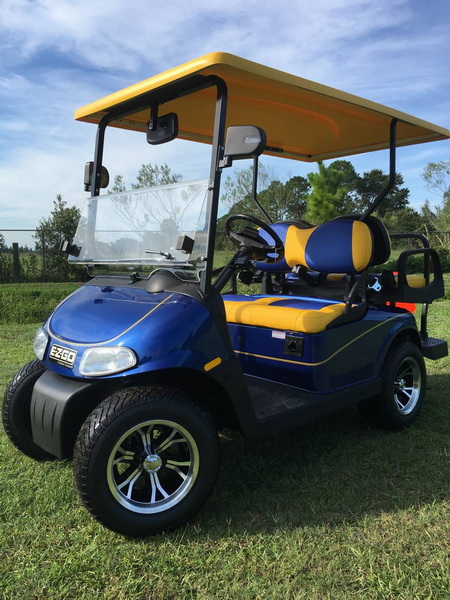Content Menu
● Understanding Electric Golf Cart Speeds
>> Typical Speed Ranges
● Factors Affecting Electric Golf Cart Speed
● Comparing Electric vs. Gas Golf Carts
● Street-Legal Electric Golf Carts
● Modifying Electric Golf Carts for Higher Speeds
● Safety Considerations for High-Speed Electric Golf Carts
● The Future of Electric Golf Cart Speeds
● Video Demonstration: Electric Golf Cart Speed Test
● Environmental Benefits of Electric Golf Carts
● Choosing the Right Electric Golf Cart for Your Needs
● Maintenance Tips for Optimal Speed Performance
● Conclusion
● FAQ
>> 1. How fast can a standard electric golf cart go?
>> 2. Are electric golf carts faster than gas-powered ones?
>> 3. Can I legally drive my electric golf cart on public roads?
>> 4. How can I increase the speed of my electric golf cart?
>> 5. What factors affect the speed of an electric golf cart?
Electric golf carts have become increasingly popular in recent years, not just on golf courses but also in various other settings such as residential communities, campuses, and recreational areas. One of the most common questions people ask about these vehicles is: "How fast is an electric golf cart?" In this comprehensive article, we'll explore the speed capabilities of electric golf carts, factors that affect their speed, and much more.

Understanding Electric Golf Cart Speeds
Electric golf carts are designed with specific speed limitations to ensure safety and comply with regulations. The average speed of a standard electric golf cart typically ranges from 12 to 14 mph. However, this can vary depending on several factors, including the model, terrain, and any modifications made to the cart.
Typical Speed Ranges
- Standard Golf Course Carts: 12-14 mph
- Street-Legal Golf Carts: 20-25 mph
- Modified or Performance Carts: Up to 25 mph or more
It's important to note that while some modified electric golf carts can achieve higher speeds, there are legal and safety considerations to keep in mind.
Factors Affecting Electric Golf Cart Speed
Several factors can influence the speed of an electric golf cart:
1. Battery Power: The voltage of the battery system plays a crucial role in determining the cart's speed potential.
2. Motor Capacity: The size and power of the electric motor directly impact the cart's performance.
3. Terrain: Flat surfaces allow for higher speeds, while inclines can reduce speed.
4. Weight: The total weight of the cart, including passengers and cargo, affects acceleration and top speed.
5. Tire Condition: Proper tire inflation and tread condition are essential for optimal speed and handling.
Comparing Electric vs. Gas Golf Carts
Contrary to popular belief, electric golf carts can be just as fast as their gas-powered counterparts. In fact, electric carts often have better acceleration due to the instant torque provided by electric motors.
| Feature | Electric Golf Cart | Gas Golf Cart |
| Top Speed | 12-25 mph | 12-19 mph |
| Acceleration | Instant torque | Gradual acceleration |
| Maintenance | Lower | Higher |
| Environmental Impact | Lower emissions | Higher emissions |
Street-Legal Electric Golf Carts
For those looking to use their electric golf carts on public roads, street-legal versions are available. These carts are designed to meet specific requirements and typically have a top speed of 20-25 mph.
To be considered street-legal, electric golf carts must usually include:
- Headlights
- Taillights
- Turn signals
- Rearview mirrors
- Seat belts
- A horn

Modifying Electric Golf Carts for Higher Speeds
Some golf cart enthusiasts choose to modify their carts to achieve higher speeds. Common modifications include:
- Upgrading the motor
- Installing a higher voltage battery system
- Modifying the controller
- Improving the suspension and brakes
It's crucial to note that modifying a golf cart may void warranties and could potentially be illegal for use on public roads or golf courses.
Safety Considerations for High-Speed Electric Golf Carts
As the speed of electric golf carts increases, so does the importance of safety measures. When operating a high-speed electric golf cart, consider the following:
- Always wear a seatbelt
- Use proper lighting when driving at night
- Observe speed limits and traffic rules
- Ensure regular maintenance of brakes and tires
- Be aware of your surroundings and potential hazards
The Future of Electric Golf Cart Speeds
As technology advances, we can expect to see improvements in electric golf cart performance, including speed capabilities. Innovations in battery technology and motor efficiency are likely to push the boundaries of what's possible while maintaining safety standards.
Video Demonstration: Electric Golf Cart Speed Test
To give you a better idea of how fast electric golf carts can go, here's a video demonstration of a speed test:
This video showcases the impressive speed capabilities of modern electric golf carts, demonstrating how they can reach speeds of up to 45 mph under certain conditions.
Environmental Benefits of Electric Golf Carts
While speed is an important factor, it's also worth noting the environmental benefits of electric golf carts:
- Zero emissions during operation
- Lower noise pollution
- Reduced dependence on fossil fuels
- Potential for solar charging integration
Choosing the Right Electric Golf Cart for Your Needs
When selecting an electric golf cart, consider the following factors:
1. Intended Use: Are you using it for golf, neighborhood transportation, or off-road adventures?
2. Speed Requirements: Do you need a standard 12-14 mph cart or a faster, street-legal option?
3. Range: How far do you need to travel on a single charge?
4. Terrain: Will you be driving on flat surfaces or hilly areas?
5. Budget: Balance your desired features with your budget constraints.
Maintenance Tips for Optimal Speed Performance
To ensure your electric golf cart maintains its speed capabilities:
- Keep batteries charged and properly maintained
- Regularly check and inflate tires to the correct pressure
- Lubricate moving parts as recommended by the manufacturer
- Clean electrical connections to prevent corrosion
- Schedule regular professional maintenance checks
Conclusion
Electric golf carts have come a long way in terms of speed and performance. While standard models typically range from 12-14 mph, street-legal and modified versions can reach speeds of 20-25 mph or more. The speed of an electric golf cart depends on various factors, including battery power, motor capacity, and terrain.
As technology continues to advance, we can expect to see even faster and more efficient electric golf carts in the future. However, it's crucial to always prioritize safety and adhere to local regulations when operating these vehicles.
Whether you're using an electric golf cart for a leisurely round of golf or as an eco-friendly mode of transportation around your community, understanding its speed capabilities and limitations is essential for safe and enjoyable operation.

FAQ
1. How fast can a standard electric golf cart go?
A standard electric golf cart typically has a top speed of 12-14 mph. This speed is designed to be safe for use on golf courses and in residential areas.
2. Are electric golf carts faster than gas-powered ones?
Electric golf carts can be just as fast as gas-powered ones, with some models even offering better acceleration due to the instant torque of electric motors. The top speeds are generally similar, ranging from 12-19 mph for both types.
3. Can I legally drive my electric golf cart on public roads?
To legally drive an electric golf cart on public roads, it must be classified as a street-legal low-speed vehicle (LSV). These typically have a top speed of 20-25 mph and must include safety features like headlights, taillights, turn signals, and seat belts.
4. How can I increase the speed of my electric golf cart?
You can increase the speed of an electric golf cart by upgrading the motor, installing a higher voltage battery system, modifying the controller, or improving the suspension and brakes. However, it's important to note that such modifications may void warranties and could be illegal for use on public roads or golf courses.
5. What factors affect the speed of an electric golf cart?
Several factors can affect the speed of an electric golf cart, including battery power, motor capacity, terrain, total weight (including passengers and cargo), and tire condition. Proper maintenance and optimal conditions can help maximize the cart's speed performance.










































